Operational Test and Evaluation of Chemical Remediation Activities (OTECRA)
Successfully Remediating a Building Following a Simulated Chemical Release
The EPA is enhancing the nation's ability to respond to and recover from a potential chemical agent incident by developing environmental remediation methods, technologies and response exercises and trainings.
In the Fall of 2022, EPA conducted the full-scale, Operational Test and Evaluation of Chemical Remediation Activities (OTECRA) field study focused on how emergency responders would clean the interior of a building that was contaminated with a chemical warfare agent (CWA). This field study builds upon a portfolio of EPA research conducted at bench- and pilot-scale. Those studies informed the deployed surface wipe sampling methods, wet-vacuum sampling approaches, and selection of different decontaminants during this full-scale field study.
At the field study, researchers and emergency responders engaged in real-world scenario testing of an indoor CWA release. The research team successfully returned a contaminated building back to its regular use through efficient sampling methods and effective decontamination technologies. These results will be available in a report which demonstrates CWA recovery capabilities, lessons learned, and identifies additional questions.
On this page:
- Test Bed
- Contamination
- Pre- and Post-decontamination Sampling
- Decontamination
- Data Management
- Waste Management
- Report and Findings
- Project Leads
Test Bed
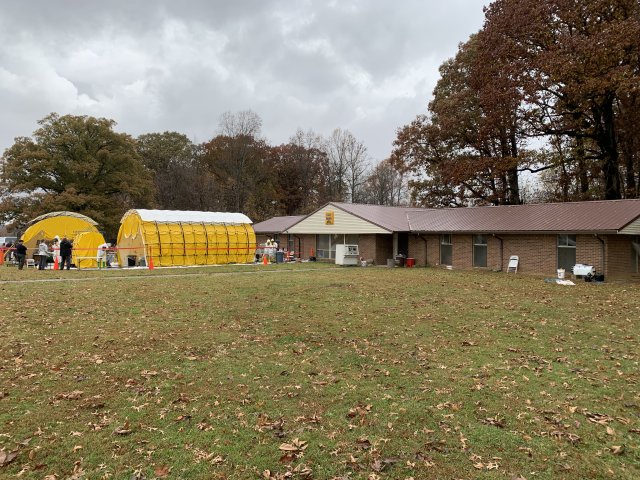
The OTECRA field study was held at the Muscatatuck Urban Training Center near Butlerville, IN. One of the buildings at this training center was configured to simulate spaces many people would encounter: office spaces and a three-room studio apartment. Five rooms were outfitted with common items that would need to be remediated in the event of a CWA incident, including wall and floor materials, tables, chairs, computers, countertops, and kitchen appliances.
The demonstration included a sequence of activities, including a contamination event, followed by pre-decontamination characterization sampling, decontamination of the interior, and post-decontamination clearance sampling. This cycle was repeated once using a different decontamination technology. Data management was included in all aspects of the study using novel approaches to identify sampling locations and directing sampling teams to these locations using electronic tablets.
Contamination
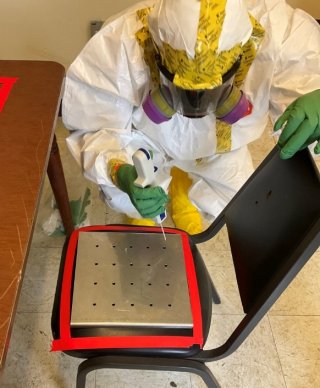
In order to simulate a real-world scenario, a chemical simulant was applied to different surfaces inside the building. Malathion, an insecticide that is commonly used in place of organophosphorus CWAs like VX for research, was applied a liquid droplets to surfaces. (Note: EPA received a Categorical Exclusion under NEPA for this field test since malathion is not authorized for indoor use.)
The contaminated area or exclusion zone was then isolated and identified with caution tape. The level of contamination was measured using reference material coupons, which are polished rectangular stainless-steel surfaces, that were placed in each room prior to contamination.
Pre- and Post-decontamination Sampling
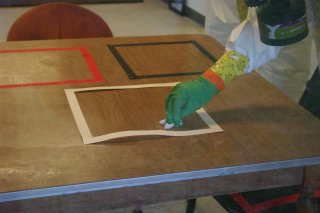
After contamination, four sampling teams conducted pre-decontamination wipe sampling to establish the concentration of malathion on surfaces (approximately 40 wipe samples were collected). Pre-decontamination sampling characterizes the level of contamination and can help responders confidently plan and implement the remediation phase. Sampling teams received just-in-time training which can be improved to provide more consistent sampling techniques.
Sampling methods and strategies were chosen in consideration of sampling analysis capacity limitations. Samples were analyzed on-site using EPA's Portable High-throughput Integrated Laboratory Identification System (PHILIS), simulating a real-world deployment during an emergency response. This asset allows EPA the capability to evaluate samples rapidly and provide next-day results for decision-makers.
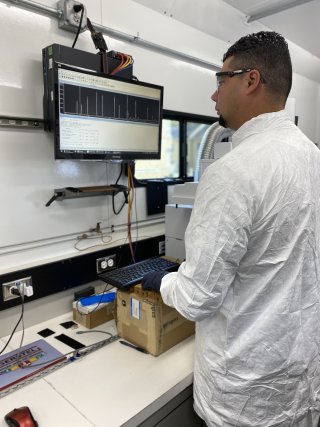
Sampling of non-porous surfaces, such as tables, floors, and walls was conducted with pre-wetted cotton gauze wipes and then analyzed on-site by PHILIS. Sampling and analysis methods were identified through EPA's Environmental Sampling and Analytical Methods Program (ESAM). Larger floor samples were collected using a novel wet-vacuum approach. These samples were taken to the on-site processing location where they were packaged and shipped to an external commercial laboratory for analysis. Reference material coupons were retrieved and shipped to EPA's laboratory in Research Triangle Park, NC for analysis of relative contamination levels of malathion. Shipment requirements of environmental samples should be considered early in an actual response or in the planning of the next full-scale study.
Following the decontamination of the building interior, the same number of sampling teams conducted post-decontamination sampling to establish whether any residual malathion remained on surfaces. Results from the post-decontamination sampling provided insight on whether the decontamination approach was successful.
Decontamination
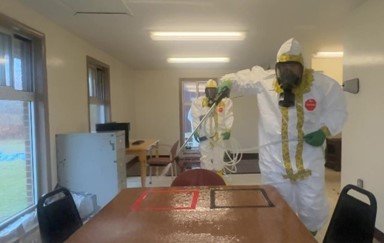
The OTECRA field study evaluated two decontamination solutions. For the first round, Decon7, an activated hydrogen peroxide containing product was applied using a low-pressure spraying system. The second round of testing involved spraying undiluted bleach in a similar manner.
The sprayers used during the exercise are commercially available and do not require extensive expertise or training to apply decontaminants. The standard shop vacuum had difficulty removing residual Decon7 and it caused the formation of significant amounts of foam. Future field studies could consider adding a defoaming chemical or wait longer until the residual product has dried.
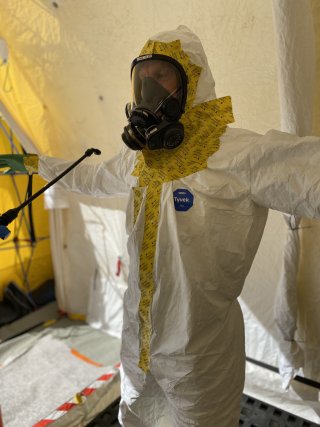
Prior to leaving the exclusion zone, responders and equipment were decontaminated to minimize the potential for cross contamination and introduction of the contaminant to areas outside the exclusion zone. A decontamination line was set up to decontaminate the personal protective equipment (PPE) they were wearing, hand-held equipment, and sample containers. Responders made their way through the decontamination line where diluted bleach was applied to their PPE, followed by a rinse off with water, and they were then patted dry. Responders were cut out of their PPE suit at the end of the decontamination line. Sample containers coming out of the exclusion zone were wiped down with bleach wipes. Improving the management of team entries into the decontamination line should avoid bottle necks in processing personnel.
Data Management
Information about the sample was closely managed with the use of a Quick Read (QR) code attached to each sample container that could be quickly scanned in the field and laboratory. Using EPA's Simple QUIck Read Label (SQUIREL) tool, researchers assigned a unique ID number to each sample. Electronic tablets were used to scan the ID and input information into ESRI's Field Maps application on collection method, sample type, sample matrices, start and end times, observations, and photographs of the sample location. The data was then uploaded into EPA's Geoplatform which generated a custom chain of custody form that was included in each sample shipment sent to the PHILIS and other two processing laboratories. The data management team used portable Wi-Fi boxes that were critical to the functionality of these tools. Testing was conducted in an area with a weak Wi-Fi signal, a likely occurrence in the event of a major disaster.
Waste Management
All waste generated during the OTECRA field study was contained, segregated, and staged for characterization and disposal by EPA's Region 5, where the exercise took place. Information from sampling and analysis on how well the decontaminant performed was used to develop waste acceptance criteria and material disposal options, a requirement for CWA incidents. All waste that was generated became part of the waste stream which was packaged and shipped to waste facilities. Waste material analyses were submitted for approval to disposal facilities in Ohio and Indiana prior to shipment.
Report and Findings
The OTECRA team compiled the data from the study and lessons learned on what worked and what didn't work well during the field study. This information, as well as identification of operational and research gaps are published as part of the EPA report.
A release of a CWA or any other highly toxic chemical remains a threat to the United States and abroad. This full-scale study enhances the Nation's ability to prepare for, respond to, and recover from a chemical agent incident by increasing responder confidence in the efficacy of sampling and decontamination methodologies, and through an improved operational perspective gained during the full-scale tests and evaluations. A strong collaboration between researchers and responders builds greater capability for the Nation to respond to potential CWA events.
References to other Bench and Pilot-scale Studies
- Remediation Options for Porous Materials Contaminated with Persistent Chemical Warfare Agents
- Efficacy and Compatibility of Decontamination Options for Sensitive Equipment-related Materials
- Assessment of Decontamination Solution Application Methods for Decontamination of Surfaces
- Water Rinses and their Impact on Decontamination Efficacies of Surfaces
Project Leads
- Lukas Oudejans, Office of Research and Development, Oudejans.Lukas@epa.gov
- Shannon Serre, Office of Land and Emergency Management, Serre.Shannon@epa.gov
- James Justice, EPA Region 5, Justice.James@epa.gov
